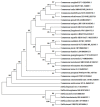The Emergence of the Genus Comamonas as Important Opportunistic Pathogens
- PMID: 36145464
- PMCID: PMC9504711
- DOI: 10.3390/pathogens11091032
The Emergence of the Genus Comamonas as Important Opportunistic Pathogens
Abstract
Comamonas spp. are non-fermenting Gram-negative bacilli. They were first discovered in 1894, and since then, twenty-four species have been characterized. The natural habitat of these bacteria is soil, wastewater/sludge, fresh water such as ponds and rivers, and the animal intestinal microbiome. They were also isolated from industrial settings, such as activated sludge and polluted soil, and from the hospital environment and clinical samples, such as urine, pus, blood, feces, and kidney. Comamonas spp. are associated with environmental bioremediation and are considered an important environmental bacterium rather than a human pathogen. However, in the 1980s, they became a concern when several human infections associated with these species were reported. Here, the Comamonas genus was examined in terms of its members, identification techniques, and pathogenicity. Seventy-seven infection cases associated with these microorganisms that have been discussed in the literature were identified and investigated in this project. All relevant information regarding year of infection, country of origin, patient information such as age, sex, underlying medical conditions if any, type of infection caused by the Comamonas species, antibiotic susceptibility testing, treatment, and outcomes for the patient were extracted from case reports. The findings suggest that even though Comamonas spp. are thought of as being of low virulence, they have caused harmful health conditions in many healthy individuals and even death in patients with underlying conditions. Antimicrobial treatment of infections associated with these species, in general, was not very difficult; however, it can become an issue in the future because some strains are already resistant to different classes of antibiotics. Therefore, these pathogens should be considered of such importance that they should be included in the hospital screening programs.
Keywords: Comamonas; environmental bacteria; nosocomial infection.
Conflict of interest statement
The authors declare no conflict of interest.
Figures

Similar articles
-
[Comamonas kerstersii bacteremia in a young man with acute appendicitis].Rev Chilena Infectol. 2020 Apr;37(2):182-185. doi: 10.4067/s0716-10182020000200182. Rev Chilena Infectol. 2020. PMID: 32730487 Spanish.
-
Polymicrobial Bacteremia Involving Comamonas testosteroni.Case Rep Med. 2014;2014:578127. doi: 10.1155/2014/578127. Epub 2014 Dec 28. Case Rep Med. 2014. PMID: 25614744 Free PMC article.
-
Brevundimonas spp: Emerging global opportunistic pathogens.Virulence. 2018 Jan 1;9(1):480-493. doi: 10.1080/21505594.2017.1419116. Virulence. 2018. PMID: 29484917 Free PMC article. Review.
-
Prevalence of multi-drug resistant bacteria associated with foods and drinks in Nigeria (2015-2020): A systematic review.Ital J Food Saf. 2021 Nov 22;10(4):9417. doi: 10.4081/ijfs.2021.9417. eCollection 2021 Nov 22. Ital J Food Saf. 2021. PMID: 35018289 Free PMC article.
-
The Genus Ochrobactrum as Major Opportunistic Pathogens.Microorganisms. 2020 Nov 16;8(11):1797. doi: 10.3390/microorganisms8111797. Microorganisms. 2020. PMID: 33207839 Free PMC article. Review.
Cited by
-
Recent Records on Bacterial Opportunistic Infections via the Dietary Route.Microorganisms. 2023 Dec 29;12(1):69. doi: 10.3390/microorganisms12010069. Microorganisms. 2023. PMID: 38257896 Free PMC article. Review.
-
Metagenomic analysis reveals diverse microbial community and potential functional roles in Baner rivulet, India.J Genet Eng Biotechnol. 2023 Nov 28;21(1):147. doi: 10.1186/s43141-023-00601-x. J Genet Eng Biotechnol. 2023. PMID: 38015339 Free PMC article.
-
Generation of green electricity from sludge using photo-stimulated bacterial consortium as a sustainable technology.Microb Cell Fact. 2023 Sep 15;22(1):183. doi: 10.1186/s12934-023-02187-y. Microb Cell Fact. 2023. PMID: 37715250 Free PMC article.
-
Microbial Inoculants as Plant Biostimulants: A Review on Risk Status.Life (Basel). 2022 Dec 21;13(1):12. doi: 10.3390/life13010012. Life (Basel). 2022. PMID: 36675961 Free PMC article. Review.
-
Non-differential gut microbes contribute to hypertension and its severity through co-abundances: A multi-regional prospective cohort study.Imeta. 2025 Jan 10;4(1):e268. doi: 10.1002/imt2.268. eCollection 2025 Feb. Imeta. 2025. PMID: 40027484 Free PMC article.
References
-
- Coughlan A., Ryan M.P., Cummins N.M., Towler M.R. The response of Pseudomonas aeruginosa biofilm to the presence of a glass polyalkenoate cement formulated from a silver containing glass. J. Mater. Sci. 2011;46:285–287. doi: 10.1007/s10853-010-4945-y. - DOI
Publication types
LinkOut - more resources
Full Text Sources
Molecular Biology Databases
Miscellaneous

